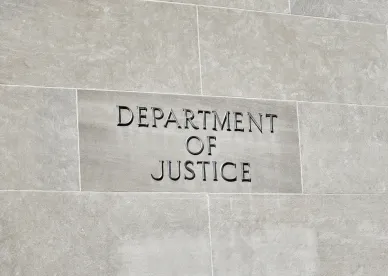The U.S. Department of Justice’s Antitrust Division (Antitrust Division) recently issued its updated Merger Remedies Manual, which sets forth a framework for structuring and implementing appropriate relief to address competitive concerns raised by mergers and acquisitions. The Merger Remedies Manual updates the Antitrust Division’s Policy Guide to Merger Remedies issued in 2004.
Under the Clayton Act, the Antitrust Division may challenge a merger that may “substantially lessen competition, or . . . tend to create a monopoly.” While the Antitrust Division may seek an injunction to prevent consummation of the transaction, in order to avoid litigation, the merging parties may enter into a consent decree that allows the transaction to proceed while still preserving competition. The Merger Remedies Manual sets forth guidance for crafting appropriate relief.
The Merger Remedies Manual identifies the following six principles that the Antitrust Division applies in structuring and implementing remedies, in both horizontal (i.e., between competitors) and vertical (i.e., between actors at different levels in the supply chain) mergers:
-
Remedies must preserve competition (replace competitive intensity that otherwise would be lost)
-
Remedies usually should be structural in nature and not create ongoing government regulation of the market
-
Temporary relief should not be used to remedy persistent competitive harm
-
The remedy should preserve competition, not protect particular competitors
-
Remedies should be designed to limit the risk of failure, but the risk of a failed remedy should fall on the merging parties, not on consumers
-
The remedy must be precise enough to be enforceable
The Merger Remedies Manual emphasizes the Antitrust Division’s preference for structural remedies—i.e., the sale of a business or assets—over conduct remedies—i.e., regulating post-merger business conduct or pricing authority. Structural remedies are strongly preferred because “they are clean and certain, effective, and avoid ongoing government entanglement in the market.” In crafting structural remedies, merging parties should keep in mind that a divestiture must include all assets necessary for the divestiture buyer to effectively compete.
While structural remedies are preferred, the Merger Remedies Manual acknowledges that conduct remedies may be appropriate in certain limited circumstances. For example, conduct remedies may be useful to facilitate effective structural relief, such as a temporary supply agreement if the purchaser is unable to manufacture the product for a limited transitional period. However, a stand-alone conduct remedy may be appropriate only where all of the following criteria are met:
-
The transaction generates significant efficiencies that cannot be achieved without the merger
-
A structural remedy is not possible
-
The conduct remedy will completely cure the anticompetitive harm
-
The remedy can be enforced effectively
The Merger Remedies Manual also identifies several red flags that increase the risk that a proposed remedy will be unacceptable:
-
Divestiture of less than a standalone business: The Antitrust Division favors divestiture of an existing standalone business (which typically includes all physical assets, personnel, customer lists, intangible assets, etc.), because divestiture of less than an existing standalone business may not result in a viable entity that will effectively preserve competition
-
Mixing and matching assets of both firms: If a divestiture combines assets or personnel that have not previously operated together, the divestiture may not effectively preserve competition
-
Allowing the merged firm to retain rights to critical intangible assets: Permitting the merged firm to retain access to intangible assets may make it more difficult for the purchaser to differentiate products from rivals or reduce the divestiture buyer’s incentive to invest in the business
-
Ongoing entanglements: The purchaser may be put in the position of having to rely on its rival to compete if there are ongoing entanglements between the merged firm and the divestiture buyer
-
Substantial regulatory or logistical hurdles: If there are substantial regulatory or logistical hurdles involved in a divestiture, it may put competition at risk if the purchaser cannot fully and independently deploy the assets during that period
The Merger Remedies Manual also addresses identification of appropriate buyers for divested assets. To start, proposed buyers must be identified to the Antitrust Division before entering into a consent decree. Additionally, the Antitrust Division will consider factors including:
-
Whether divestiture of the assets to the proposed purchaser would cause competitive harm
-
Whether the purchaser has the incentive to use the divested assets to compete in the relevant market
-
Whether the purchaser has sufficient acumen, experience, and financial capability to compete effectively in the market over the long term.
The Merger Remedies Manual notes that in some cases a private equity purchaser—particularly when partnering with others with relevant experience—may be preferred based on a Federal Trade Commission study showing that such purchasers had flexibility in investment strategy, were committed to the divestiture, and were willing to invest more when necessary.
Finally, the Merger Remedies Manual emphasizes that “[i]t is essential to the Division’s mission that all merger remedies are strictly enforced.” The Manual describes several standard consent decree terms that are designed to improve the effectiveness of consent decrees. It also highlights the role of the newly created Office of Decree Enforcement and Compliance, which oversees the Antitrust Division’s decree compliance efforts, including through use of civil and criminal contempt proceedings as appropriate.




 />i
/>i

